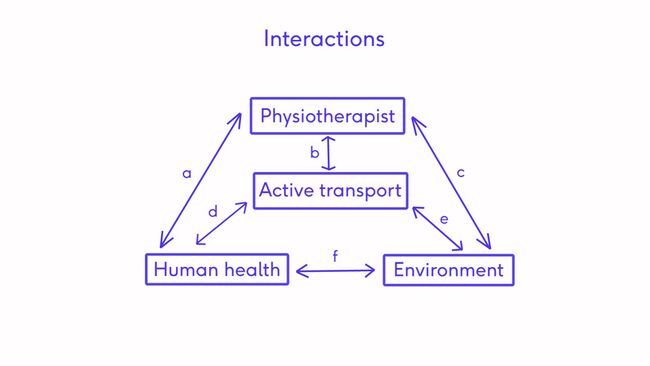Active Transportation and Planetary Health
Top Contributors - Carin Hunter, Jess Bell, Wanda van Niekerk, Kim Jackson, Tarina van der Stockt, Lucinda hampton and Olajumoke Ogunleye
What is Planetary Health?[edit | edit source]
Human health and our own existence depend on flourishing natural systems and that these stewardship of these systems and helping them thrive help us thrive to. Physiotherapy is widely recognised as being an important stakeholder in population health. Planetary health itself is seen as it's a growing and an important part of population health.
What is Active Transport?[edit | edit source]
Active Transport is defined as:
- walking
- cycling
- scooters
- jogging
Active transport can be anything that involves physical activity to or from a place of work or school. If an individual uses public transport, walking or biking to that stop is also defined as active transport as it is seen as a planetary health intervention.[1] If physiotherapy, as a profession, can help to increase active transportation, we might also see an increase in physical activity, which will simultaneously have a positive impact on the environment.[2]
a) The interaction between Physiotherapist and Human health[edit | edit source]
If an individual has a health problem, or an injury, they are going to go seek healthcare, possibly a physiotherapist. That physiotherapist is going to have an impact on their health by supporting their own improvements, whether that be educating them, giving them certain advice, obviously administering interventions or giving them an exercise program[3].
b) The interaction between the Physiotherapist and Active transportation[edit | edit source]
Active transportation might allow more access to physiotherapy for patients. As the physical therapist, active transportation might be promoted as a way for a patient to increase their own physical activity.
c) The interaction between the Physiotherapist and the Environment[edit | edit source]
This refers to more the built environment, and not the natural environment. [4]As a physiotherapist, you could advocate for change in the built environment in such a way that it might help access to physiotherapy or might help access to other facilities that are important to that patient.[5]
d) The interaction between Active transport and Human health[edit | edit source]
The hypothesis is that if we increase someone's active transportation, that in itself is going to increase their physical activity, which will have a positive impact on their health. However, starting off with poor health might itself be a barrier to engaging in active transportation.
e) The interaction between Active transport and the Environment[edit | edit source]
In this case, we refer to both the built and the natural environment. If people engage more in active transportation to increase their physical activity, this could have a positive impact on the environment by helping to reduce emissions through less private car use.[6] The environment in which a person lives in or where they want to exercise can easily encourage or discourage people from exercising and to use active transportation as a measure to increase their physical activity.
f) The interaction between Human health and the Environment[edit | edit source]
A biodiversity loss can adversely impact human health. On the opposite of the spectrum, a reduction in human health might adversely impact the environment. Lifestyle choices that involve overconsumption, whether that be medical supplies or pharmaceuticals.
If we use the COVID-19 pandemic as an example, with the increased use of masks and disposable masks, we are starting to see more of littering of these masks. Often where our own health is impacted, this can have a direct impact on the environment too.[7]
Interventions, Considerations and Recommendations[edit | edit source]
| Recommendations |
|---|
| Encourage active transport as a form of PA to improve individual and population health while yielding, additional health-related environmental benefits. |
| Educate physiotherapists and patients alike about the link between active transport, environment, personal and public health. |
| Advocate for safe and better infrastructure for active transport. |
| Advocate for more green spaces and less motorized streets without furthering socio-economic divides. |
| Advocate for active transport routes in close proximity to biodiverse green spaces, and blue spaces. |
| Advocate to make e-bikes and bike-share facilities more accessible to those populations that are unable to afford them but need them the most. |
| Advocate for better integration of active transport with sustainable public transport in a way that ensures physical and financial accessibility. |
References[edit | edit source]
- ↑ Toner A, Lewis JS, Stanhope J, Maric F. Prescribing active transport as a planetary health intervention–benefits, challenges and recommendations. Physical Therapy Reviews. 2021 Jan 19:1-9.
- ↑ Maric F, Nicholls D. A call for a new environmental physiotherapy-An editorial.
- ↑ Maric F, Chance-Larsen K, Chevan J, Jameson S, Nicholls D, Opsommer E, Perveen W, Richter R, Stanhope J, Stone O, Strimpakos N. A progress report on planetary health, environmental and sustainability education in physiotherapy–Editorial.
- ↑ Oyeyemi AL, Kolo SM, Oyeyemi AY, Omotara BA. Neighborhood environmental factors are related to health-enhancing physical activity and walking among community dwelling older adults in Nigeria. Physiotherapy theory and practice. 2019 Mar 4;35(3):288-97.
- ↑ Holmqvist LW, von Koch L. Environmental factors in stroke rehabilitation: Being in hospital itself demotivates patients.
- ↑ Mizdrak A, Blakely T, Cleghorn CL, Cobiac LJ. Potential of active transport to improve health, reduce healthcare costs, and reduce greenhouse gas emissions: A modelling study. PloS one. 2019 Jul 17;14(7):e0219316.
- ↑ Maric F, Nicholls DA. Paradigm shifts are hard to come by: Looking ahead of COVID-19 with the social and environmental determinants of health and the UN SDGs. European Journal of Physiotherapy. 2020 Nov 1;22(6):379-81.







